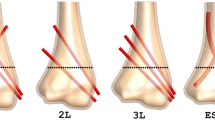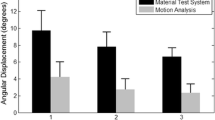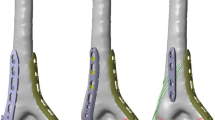Abstract
Background
Metaphyseal-diaphyseal junction (MDJ) fractures of the distal humerus are problematic to reduce and more susceptible to post-operative complications. This biomechanical study was designed to compare Kirschner wires (KW), lateral external fixation, and elastic stable intramedullary nails (ESIN) in simulated transverse MDJ fractures of various heights.
Method
Sagittally oblique, transverse MDJ fractures were created in fourth-generation composite bone models at three levels: high, mid, and low fractures, respectively, and then fixed with either Kirschner wires, lateral external fixation (EF), or ESIN respectively and tested in extension, flexion, valgus, varus, internal, and external rotations.
Results
In the high fractures, ESIN had better overall stiffness than the other techniques. In the mid groups, three crossed pinning (1-medial and 2-lateral pins) had the best overall stiffness, followed by two crossed pinning (1-medial and 1-lateral pins). In the low fractures, three crossed pinning was superior to all other techniques. Two crossed pinning and three -lateral pinning techniques yielded comparable stiffness in the low fracture model.
Conclusions
From a biomechanical perspective, ESIN provides the best overall stability for fractures located in the upper region of the MDJ, while percutaneous pinning is superior in stabilizing fractures of the lower region. Two lateral and one medial pins make the most stable crossed pinning construct for these fractures.





Similar content being viewed by others
References
Bahk MS, Srikumaran U, Ain MC, Erkula G, Leet AI, Sargent MC, Sponseller PD (2008) Patterns of pediatric supracondylar humerus fractures. J Pediatr Orthop 28(5):493–499. https://doi.org/10.1097/BPO.0b013e31817bb860
Fayssoux RS, Stankovits L, Domzalski ME, Guille JT (2008) Fractures of the distal humeral metaphyseal-diaphyseal junction in children. J Pediatr Orthop 28:142–146. https://doi.org/10.1097/BPO.0b013e3181653af3
Dekker AE, Krijnen P, Schipper IB (2016) Results of crossed versus lateral entry K-wire fixation of displaced pediatric supracondylar humeral fractures: a systematic review and meta-analysis. Injury 47:2391–2398. https://doi.org/10.1016/j.injury.2016.08.022
Lacher M, Schaeffer K, Boehm R, Dietz HG (2011) The treatment of supracondylar humeral fractures with elastic stable intramedullary nailing (ESIN) in children. J Pediatr Orthop 31:33–38. https://doi.org/10.1097/BPO.0b013e3181ff64c0
Marengo L, Canavese F, Cravino M, De Rosa V, Rousset M, Samba A, Mansour M, Andreacchio A (2015) Outcome of displaced fractures of the distal metaphyseal-diaphyseal junction of the humerus in children treated with elastic stable intramedullary nails. J Pediatr Orthop 35:611–616. https://doi.org/10.1097/BPO.0000000000000340
Sénès FM, Catena N (2012) Intramedullary osteosynthesis for metaphyseal and diaphyseal humeral fractures in developmental age. J Pediatr Orthop B 21:300–304. https://doi.org/10.1097/BPB.0b013e328353d96d
Slongo T, Schmid T, Wilkins K, Joeris A (2008) Lateral external fixation—a new surgical technique for displaced unreducible supracondylar humeral fractures in children. J Bone Joint Surg Am 90:1690–1697. https://doi.org/10.2106/JBJS.G.00528
Hamdi A, Poitras P, Louati H, Dagenais S, Masquijo JJ, Kontio K (2010) Biomechanical analysis of lateral pin placements for pediatric supracondylar humerus fractures. J Pediatr Orthop 30:135–139. https://doi.org/10.1097/BPO.0b013e3181cfcd14
Feng C, Guo Y, Zhu Z, Zhang J, Wang Y (2012) Biomechanical analysis of supracondylar humerus fracture pinning for fractures with coronal lateral obliquity. J Pediatr Orthop 32:196–200. https://doi.org/10.1097/BPO.0b013e318242a99a
Wagner FC, Strohm PC, Südkamp NP, Reising K (2015) Biomechanical evaluation of a new technique for external fixation of unstable supracondylar humerus fractures in children. Technol Health Care 23:453–461. https://doi.org/10.3233/THC-150905
Sen RK, Tripathy SK, Kumar A, Agarwal A, Aggarwal S, Dhatt S (2012) Metaphyseo-diaphyseal junction fracture of distal humerus in children. J Pediatr Orthop B 21:109–114. https://doi.org/10.1097/BPB.0b013e32834ba9d6
Ge YH, Wang ZG, Cai HQ, Yang J, Xu YL, Li YC (2014) Flexible intramedullary nailing had better outcomes than Kirschner wire fixation in children with distal humeral metaphyseal-diaphyseal junction fracture: a retrospective observational analysis. Int J Clin Exp Med 7:3568–3572
Havránek P, Pesl T (2002) Use of the elastic stable intramedullary nailing technique in non-typical pediatric fractures. Acta Chir Orthop Traumatol Cechoslov 69(2):73–78
Schäffer K, Böhm R, Dietz HG (2007) Elastic stable intramedullary nailing (ESIN) of supracondylar fractures of the humerus in children. Unfallchirurg 110(10):852–858
Cosma D, Vasilescu DE (2014) Elastic stable intramedullary nailing for fractures in children—specific applications. Clujul Med 87(3):147–151. https://doi.org/10.15386/cjmed-275
Ligier JN, Metaizeau JP, Prévot J, Lascombes P (1988) Elastic stable intramedullary nailing of femoral shaft fractures in children. J Bone Joint Surg Br 70(1):74–77
Flynn JM, Skaggs DL (2010) Femoral shaft fractures. In: Beaty JH, Kasser JR (eds) Rockwood and Wilkins fractures in children, 7th edn. Lippincott Williams & Wilkins, Philadelphia, p 812
Weinberg AM, Castellani C, Arzdorf M, Schneider E, Gasser B, Linke B (2007) Osteosynthesis of supracondylar humerus fractures in children: a biomechanical comparison of four techniques. Clin Biomech (Bristol, Avon) 22:502–509
Prashant K, Lakhotia D, Bhattacharyya TD, Mahanta AK, Ravoof A (2016) A comparative study of two percutaneous pinning techniques (lateral vs medial-lateral) for Gartland type III pediatric supracondylar fracture of the humerus. J Orthop Traumatol 17:223–229. https://doi.org/10.1007/s10195-016-0410-2
Slobogean BL, Jackman H, Tennant S, Slobogean GP, Mulpuri K (2010) Iatrogenic ulnar nerve injury after the surgical treatment of displaced supracondylar fractures of the humerus: number needed to harm, a systematic review. J Pediatr Orthop 30(5):430–436. https://doi.org/10.1097/BPO.0b013e3181e00c0d
Gottschalk HP, Sagoo D, Glaser D, Doan J, Edmonds EW, Schlechter J (2012) Biomechanical analysis of pin placement for pediatric supracondylar humerus fractures: does starting point, pin size, and number matter? J Pediatr Orthop 32:445–451. https://doi.org/10.1097/BPO.0b013e318257d1cd
Jaeblon T, Anthony S, Ogden A, Andary JJ (2016) Pediatric supracondylar fractures: variation in fracture patterns and the biomechanical effects of pin configuration. J Pediatr Orthop 36:787–792
Landsman AS, Chang TJ (1998) Can synthetic bone models approximate the mechanical properties of cadaveric first metatarsal bone? J Foot Ankle Surg 37:122–127
Hohloch L, Konstantinidis L, Wagner FC, Strohm PC, Südkamp NP, Reising K (2016) Biomechanical comparison of different external fixator configurations for stabilization of supracondylar humerus fractures in children. Clin Biomech (Bristol, Avon) 32:118–123. https://doi.org/10.1016/j.clinbiomech.2015.12.003
Lee SS, Mahar AT, Miesen D, Newton PO (2002) Displaced pediatric supracondylar humerus fractures: biomechanical analysis of percutaneous pinning techniques. J Pediatr Orthop 22(4):440–443
Author information
Authors and Affiliations
Corresponding author
Ethics declarations
Conflict of interest
The authors declare that they have no conflict of interest.
Ethical approval
This article does not contain any studies with human participants or animals performed by any of the authors.
Rights and permissions
About this article
Cite this article
Kamara, A., Ji, X., Liu, T. et al. A comparative biomechanical study on different fixation techniques in the management of transverse metaphyseal-diaphyseal junction fractures of the distal humerus in children. International Orthopaedics (SICOT) 43, 411–416 (2019). https://doi.org/10.1007/s00264-018-3968-x
Received:
Accepted:
Published:
Issue Date:
DOI: https://doi.org/10.1007/s00264-018-3968-x




